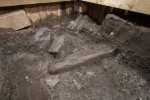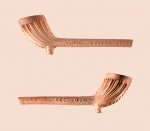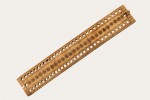As part of an extensive redevelopment of London Bridge Station, the city’s oldest rail station (opened in 1836), archaeologists have had the unique opportunity to excavate underneath the station and its viaduct. The station has a vast footprint and since it was constructed long before archaeological surveys were invented, this is the first chance archaeologists have had to explore the site. Other excavations in the London Bridge area have revealed a great deal about the growth and development of the city from the Roman era on, but the station site was thought to have been either very marshy or fully underwater for much of its history that archaeologists weren’t sure what they’d find.
 They found that although the area was certainly marshy and waterlogged it may have been, but it was still extensively developed. Excavations have gone as deep as 20 feet below street level in the massive arches of the station foundations. The earliest finds were traces of the Roman military occupation followed by evidence of the Boudican rebellion and the Roman civilian settlement. The remains of three previously unknown Roman structures were found: a bathhouse, a large waterfront building and what may have been a boat landing platform. Thanks to the preserving power of the waterlogged ground along the Thames, rare organic elements have survived, like 17 timbers piles from trees felled between 59 and 83 A.D. which were part of the foundations of the large waterfront building. The landing platform consists of a timber baulk packed with rocks and wood.
They found that although the area was certainly marshy and waterlogged it may have been, but it was still extensively developed. Excavations have gone as deep as 20 feet below street level in the massive arches of the station foundations. The earliest finds were traces of the Roman military occupation followed by evidence of the Boudican rebellion and the Roman civilian settlement. The remains of three previously unknown Roman structures were found: a bathhouse, a large waterfront building and what may have been a boat landing platform. Thanks to the preserving power of the waterlogged ground along the Thames, rare organic elements have survived, like 17 timbers piles from trees felled between 59 and 83 A.D. which were part of the foundations of the large waterfront building. The landing platform consists of a timber baulk packed with rocks and wood.
 Later discoveries include the remains of Saxon defenses and the floors and walls of large townhouses on Tooley Street which the historical record identifies as the abodes of important medieval clerics like the Prior of Lewes. (The remains of other such homes owned by non-London religious orders can be found today at Winchester and Lambeth Palace.) From the late Middle Ages on, the marshy land was extensively reclaimed for industrial and residential purposes. The remains of floors, walls and cellars testify to dense, closely-built buildings packed along a network of small streets.
Later discoveries include the remains of Saxon defenses and the floors and walls of large townhouses on Tooley Street which the historical record identifies as the abodes of important medieval clerics like the Prior of Lewes. (The remains of other such homes owned by non-London religious orders can be found today at Winchester and Lambeth Palace.) From the late Middle Ages on, the marshy land was extensively reclaimed for industrial and residential purposes. The remains of floors, walls and cellars testify to dense, closely-built buildings packed along a network of small streets.
 Hundreds of artifacts were also found mirroring the changing phases of the London Bridge station area. A Penn Tile, made in Penn, Buckinghamshire, between 1330 and 1390, was used as flooring in an expensive building. These glazed patterned tiles became popular in London after the Black Death obliterated local tile producers. Also from the 14th century is a rare white clay flagon, probably made in Cheam, that archaeologists believe was used to serve ale in the townhouse of the Abbot of Waverley. Now it’s on display at the Wheatsheaf Pub in Stoney Street.
Hundreds of artifacts were also found mirroring the changing phases of the London Bridge station area. A Penn Tile, made in Penn, Buckinghamshire, between 1330 and 1390, was used as flooring in an expensive building. These glazed patterned tiles became popular in London after the Black Death obliterated local tile producers. Also from the 14th century is a rare white clay flagon, probably made in Cheam, that archaeologists believe was used to serve ale in the townhouse of the Abbot of Waverley. Now it’s on display at the Wheatsheaf Pub in Stoney Street.
 Starting in the 16th century in the wake of the introduction of tobacco from the New World there was a bustling business of clay pipe manufacturers in the neighborhood. These were mainly small backyard workshops. Archaeologists found the remains of a pope kiln that had been demolished centuries ago which proved fortuitous from an archaeological perspective because it allowed the excavators to find pieces of the superstructure. They also found many pipes, some whole, some discarded and broken after a failed firing. One pipe is marked with wording that identifies its maker. “JOINER STREET” is written on one side of the stem and “TOOLEY STREET BORO” on the other, indicating it was made by James Minto between 1809 and 1811. That means the clay pipe industry was still producing a couple of decades before the construction of the station.
Starting in the 16th century in the wake of the introduction of tobacco from the New World there was a bustling business of clay pipe manufacturers in the neighborhood. These were mainly small backyard workshops. Archaeologists found the remains of a pope kiln that had been demolished centuries ago which proved fortuitous from an archaeological perspective because it allowed the excavators to find pieces of the superstructure. They also found many pipes, some whole, some discarded and broken after a failed firing. One pipe is marked with wording that identifies its maker. “JOINER STREET” is written on one side of the stem and “TOOLEY STREET BORO” on the other, indicating it was made by James Minto between 1809 and 1811. That means the clay pipe industry was still producing a couple of decades before the construction of the station.
 In the fun category, archaeologists found a rare cribbage board made out of animal bone in the 17th or 18th century. The game was invented in the 17th century, so this piece could be a very early example. I love those concentric circles down the middle. They look just like the marks on much earlier dice, like this one from 13th or 14th century Ireland.
In the fun category, archaeologists found a rare cribbage board made out of animal bone in the 17th or 18th century. The game was invented in the 17th century, so this piece could be a very early example. I love those concentric circles down the middle. They look just like the marks on much earlier dice, like this one from 13th or 14th century Ireland.
 My favorite find is a set of three pewter tankards from the 18th century. They were discovered in a cess pit, possibly because the bends and twists around the lip made them hard to drink from, but they still look great. Two of them are inscribed with the names of the hostelries where they were once used to quaff lukewarm brews. One says “Mary Jackson, Kings head, Tooley Strt,” the other “J main, St Johns Coffee house, Bermondsey Strt”. The best part: the The Old Kings Head is still open for business today, not on Tooley Street but very close by on Borough High Street.
My favorite find is a set of three pewter tankards from the 18th century. They were discovered in a cess pit, possibly because the bends and twists around the lip made them hard to drink from, but they still look great. Two of them are inscribed with the names of the hostelries where they were once used to quaff lukewarm brews. One says “Mary Jackson, Kings head, Tooley Strt,” the other “J main, St Johns Coffee house, Bermondsey Strt”. The best part: the The Old Kings Head is still open for business today, not on Tooley Street but very close by on Borough High Street.
Very remarkable excavation!